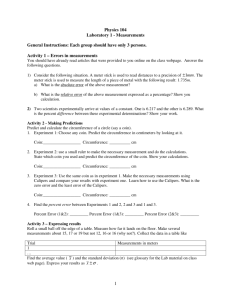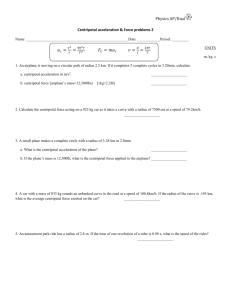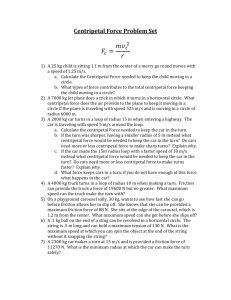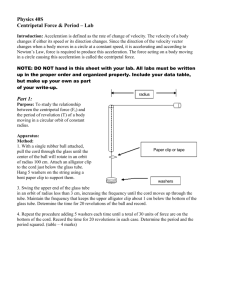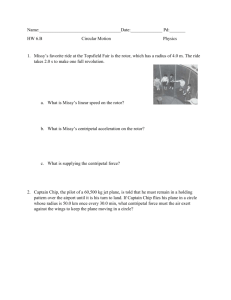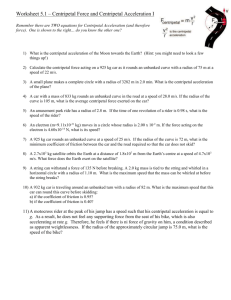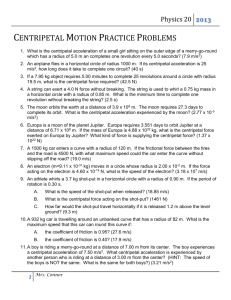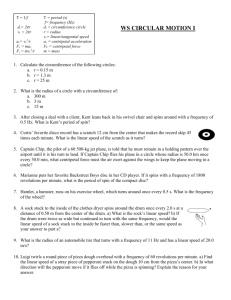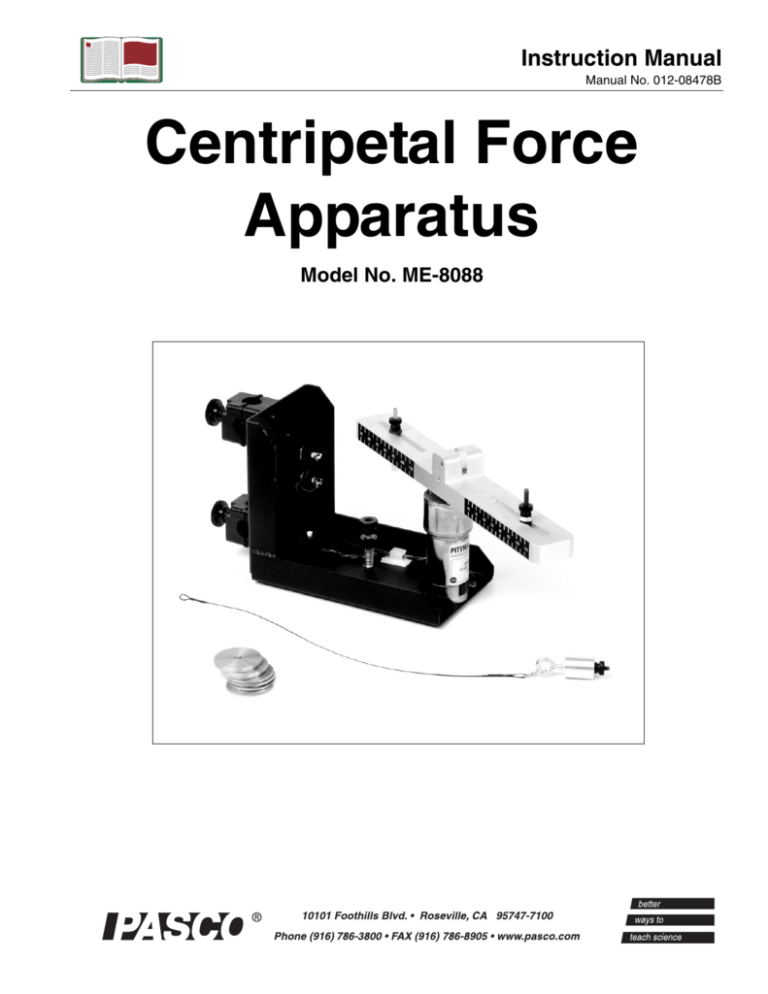
Instruction Manual
Manual No. 012-08478B
Centripetal Force
Apparatus
Model No. ME-8088
Centripetal Force Apparatus
Model No. ME-8088
Table of Contents
Equipment List........................................................ 3-4
Introduction ............................................................. 5
Equipment Setup ..................................................... 5-7
Suggested Experiments ................................................. 8
Experiment 1: Centripetal Force vs. Velocity............................................................................ 8-9
Experiment 2: Centripetal Force vs. Mass ............................................................................. 10-11
Experiment 3: Centripetal Force vs. Radius .......................................................................... 12-13
Sample Data/Results...................................................14
Troubleshooting ........................................................15
Appendix A:Specifications............................................. 16
Appendix B: DataStudio Setup Instructions (for PASPORT interfaces)
.......................................................................... 17
Appendix C: DataStudio Setup Instructions (for ScienceWorkshop
interfaces).............................................................. 18
Appendix D: Technical Support ....................................... 19
Appendix E: Copyright and Warranty Information .................. 19
2
®
Model No. ME-8088
Centripetal Force Apparatus
Centripetal Force Apparatus
Model No. ME-8088
Equipment List
1
5
4
2
3
8
7
6
Included Equipment
Replacement
Model Number*
1. Frame with Mounted Electric Motor (1)
NA
623-038
2. Connecting Cable (1)
003-08383
3. Ball Bearing Swivel (1)
4. Thumbscrew for Photogate (1)
614-034
5. Nuts for Free and Fixed Mass Holders (2)
614-029
6. 5 g Mass (2)
648-06507
7. 10 g Mass (2)
648-06508
8. 20 g Mass (2)
648-06509
9. Centripetal Force Apparatus Setup disk (3.5” floppy) (not shown above)
013-08478
*Use Replacement Model Numbers to expedite replacement orders.
NA = not available as individual replacement item. To replace product, use ME-8088.
(continued on next page)
®
3
Centripetal Force Apparatus
Additional Equipment Recommended for Experiments (with
ScienceWorkshop)
A computer (Windows or Macintosh)
Replacement
Model Number*
NA
DataStudio® Software
various (see catalog)
ScienceWorkshop® 500 or 750 Interface
CI-6400 or CI-6450 or
CI-7650
Economy Force Sensor
Photogate Head
Steel Rod (45 or 120 cm)
CI-6746
ME-9498A
ME-8736 and
ME-8741
Multi-Clamp
SE-9442
Large Rod Base
ME-8735
Banana plugs (1 red, 1 black)
Triple Output Power Supply (12 V, 3 A) (1)
Additional Equipment Recommended for Experiments (with
PASPORT™ )
A USB-compatible computer (Windows or Macintosh)
DataStudio Software (version 1.5 or later)
SE-9750 or SE-9751
SE-8587
Replacement
Model Number*
NA
various (see catalog)
PASPORT™ Force Sensor
PS-2104
Photogate Port
PS-2123
Photogate Head
USB Link (2) or Xplorer (2) or PowerLink
Steel Rod (45 or 120 cm)
ME-9498A
PS-2100 or PS-2000
or PS-2001
ME-8736 and
ME-8741
Multi-Clamp
SE-9442
Large Rod Base
ME-8735
Banana plugs (1 red, 1 black)
Triple Output Power Supply
4
Model No. ME-8088
SE-9750 or SE-9751
SE-8587
®
Model No. ME-8088
Centripetal Force Apparatus
Introduction
PASCO’s Centripetal Force Apparatus
(ME-8088) allows students to investigate
the relationships between centripetal
force, radius, mass, and velocity for an
object undergoing uniform circular
motion. Traditional experiments in this
area involve the swinging of masses above
the head. The traditional approach is
difficult to execute and data is rarely
sufficient for an understanding of the
relationships. The Centripetal Force
Apparatus removes these difficulties by
using sensors to measure the force and
velocity of the mass as it rotates.
Figure 1: Setup with Force
Sensor on stand
Velocity is varied by changing the voltage
supplied to the included electric motor.
Drilled masses are included to facilitate a range of mass trials. The radius is
changed by sliding the captured masses along the grooves in the rotating
arm. A convenient measuring scale is included on both sides of the arm.
The sturdy base includes rod clamps for connection to a standard rod stand
or the unit can be clamped to a table using a common “C” clamp.
Equipment Setup
1. Mount a stainless steel rod into
a base support stand.
2. Use the rod clamps to attach
the Centripetal Force
Accessory to the rod (See
Figure 2).
3. Remove the free mass holder
(Figure 3) and measure its
mass. To remove the free mass
holder, loosen the screw below
the rotating arm.
®
rod
base stand
Figure 2: Mounting the
Centripetal Force Accessory
5
Centripetal Force Apparatus
Model No. ME-8088
(Note: The free mass holder includes the screw, two plastic
washers, nut, and two thumbscrews. If a scale is not available, use
the mass provided in Appendix A: Specifications.)
Free Mass Holder
Fixed Mass Holder
Figure 3: Free and Fixed Mass Holders
4. Use a thumbscrew to
mount a Photogate
Head (ME-9498A)
to the bottom base of
the Centripetal Force
Accessory (See
Figure 4).
5. Attach a MultiClamp to the upper
end of the stainless
steel rod. (Figure
5a).
photogate
thumb
screw
cable
to interface
Figure 4: Photogate on base of
Centripetal Apparatus
Note: To calibrate the
ScienceWorkshop Force
Sensor, follow the
instructions provided in
the documentation
included with your
Force Sensor or in the
DataStudio online help.
Calibration of the
PASPORT Force Sensor
is not required.
However, you can tare
the PASPORT Force
Sensor by pressing the
Zero button without any
weight attached.
6. Insert another stainless steel rod horizontally into the Multi-Clamp.
7. Slide a Force Sensor through the stainless steel rod and adjust the
top screw to anchor it to the rod (Figure 5a). (Note: Be sure to keep
the cords from the sensor out of the path of the rotating arm.)
swivel
clamp
cable
Force
Sensor
Figure 5a: Mounting the Force
Sensor
6
free mass
holder
pulley
Figure 5b: Threading the cable
through the free mass holder
®
Model No. ME-8088
Centripetal Force Apparatus
8. Attach the ball bearing swivel to the bottom of the Force Sensor
9. Thread the cable from the swivel hook through the pulley and over
the free mass holder (Figure 5b).
Note: Always lay down the cable before adding the mass.
10. Add a mass to the free mass holder; then screw on the thumbscrew
to hold the mass in place.
11. Add a mass to the fixed mass holder and use a thumbscrew to hold
the mass in place.
12. Plug the Force Sensor into either a PASPORT or ScienceWorkshop
interface.
13. Use banana plugs to
connect the
Centripetal Force
Accessory to a Power
Supply.
14. To turn on the motor
to the Centripetal
Force Accessory, turn
on the Power Supply.
(CAUTION: To avoid
damaging the equipment,
keep all cords away from
the motor and rotating
arm.)
Force
Sensor
Power
Supply
interface
Note: If you do not have
a setup disk available,
follow the DataStudio
setup instructions in
Appendix B (for
PASPORT sensors) or C
(for ScienceWorkshop
sensors).
Figure 6: Complete setup for
experiments
WARNING: Do not stand next to the motor or rotating arm or
look at the rotating arm at eye level. To avoid possible injury from the
rotating arm hitting the body, keep at least 1 foot distance from the
motor and rotating arm when running the motor.
®
7
Centripetal Force Apparatus
Model No. ME-8088
Suggested Experiments
Experiment 1: Centripetal Force vs. Velocity
Equipment Required (for use with
ScienceWorkshop sensors):
Equipment Required (for use with
PASPORT sensors):
ScienceWorkshop Force Sensor (CI-6746)
PASPORT Force Sensor (PS-2104)
Photogate Head (ME-9498A)
Photogate Head (ME-9498A)
ScienceWorkshop interface (500, 700, or
750) (CI-6400 or CI-6450)
Photogate Port (PS-2123)
Power Supply (12 v, 3A) (SE-8587)
USB Link (2) (PS-2100) or Xplorer (2) (PS2000) or Power Link (PS-2001)
DataStudio Software (ver. 1.5 or higher)
Power Supply (12 V, 3AA) (SE-8587)
Base support, clamps, and mounting rods
DataStudio Software (ver. 1.5 or higher)
Base support, clamps, and mounting rods
Introduction
In this experiment, you will vary the velocity by changing the voltage
to the electric motor as the centripetal force is continuously measured
by the Force Sensor. The radius and mass are held constant as the
velocity is increased.
Setup
Follow the equipment setup instructions on pages 5-7 of this manual
and the Experiment Tips that follow. When you are ready to begin the
experiment, open the appropriate DataStudio file on the setup disk.
voltage
adjustment
knob
Figure 1a: Adjusting the
voltage on the Power Supply
8
Note: If you do not have
a setup disk available,
follow the DataStudio
setup instructions in
Appendix B (for
PASPORT sensors) or C
(for ScienceWorkshop
sensors).
Figure 1b: Complete setup
®
Model No. ME-8088
Centripetal Force Apparatus
Experiment Tips
a) To add the free mass, lay the components over the attachment screw in
the following order: a) cable b) mass and c) thumbscrew to tighten.
(Note: Place the cable over the washer and nut on the screw. For more
details, see “Equipment Setup” on pages 5-7.)
Note: Do not place the mass underneath the cable, as this will
interfere with a proper measurement.
b) Allow the “free mass” plenty of length along its holder within the
slot. If the mass is not free to slide along the groove, significant
frictional losses can be present.
c) Place an equal amount of mass on the “fixed mass” and “free mass”
holders.
d) Be sure to place the “fixed mass” at the same radius as the “free
mass” to ensure balancing of the unit at is rotates.
e) The velocity of the free mass can be measured as an angular or
linear velocity. DataStudio files for both of these variations are
included on the floppy disk.
f) Be sure to enter the correct value for the radius in the experimental
constants area of the calculator (when using the linear velocity
DataStudio file).
Figure 1c: Calculator Dialog box
®
9
Centripetal Force Apparatus
Model No. ME-8088
Experiment 2: Centripetal Force vs. Mass
Equipment Required (for use with
ScienceWorkshop sensors):
Equipment Required (for use with
PASPORT sensors):
ScienceWorkshop Force Sensor (CI-6746)
PASPORT Force Sensor (PS-2104)
Photogate Head (ME-9498A)
Photogate Head (ME-9498A)
ScienceWorkshop interface (500, 700, or
750) (CI-6400 or CI-6450)
Photogate Port (PS-2123)
Power Supply (12 v, 3A) (SE-8587)
USB Link (2) (PS-2100) or Xplorer (2) (PS2000) or Power Link (PS-2001)
DataStudio Software (ver. 1.5 or higher)
Power Supply (12 V, 3AA) (SE-8587)
Base support, clamps, and mounting rods
DataStudio Software (ver. 1.5 or higher)
Base support, clamps, and mounting rods
Introduction
In this experiment, the radius and velocity are held constant as the mass is
varied. By adding additional drilled masses to the holder, the mass of the
system is increased. Equal amounts of mass must also be added to the “fixed
mass” to balance the arm as it rotates. Centripetal force is directly measured
by the Force Sensor.
Setup
Follow the equipment setup instructions on pages 5-7 of this manual
and the Experiment Tips below. When you are ready to begin the
experiment, open the appropriate DataStudio file on the setup disk.
Free mass
“Fixed” mass
Note: If you do not have
a setup disk available,
follow the DataStudio
setup instructions in
Appendix B (for
PASPORT sensors) or C
(for ScienceWorkshop
sensors).
Rotating Arm
Figure 2a: Free and fixed
Mass Holders
10
Figure 2b: Complete setup
®
Model No. ME-8088
Centripetal Force Apparatus
Experiment Tips
a) To add the free mass, lay the components over the attachment screw in
the following order: a) cable b) mass and c) thumbscrew to tighten.
(Note: Place the cable over the washer and nut on the screw. For more
details, see “Equipment Setup” on pages 5-7.)
Note: Do not place the mass underneath the cable, as this will
interfere with a proper measurement.
b) Allow the “free mass” plenty of length along its holder within the
slot. If the mass is not free to slide along the groove, significant
frictional losses can be present.
c) Place an equal amount of mass on the “fixed mass” and “free mass”
holders.
d) Be sure to place the “fixed mass” at the same radius as the “free
mass” to ensure balancing of the unit at is rotates.
e) Perform several different data runs, each time varying the mass on
the free and fixed mass holders. (Note: Be sure to include the mass
of the holders in your calculations.)
f) In the DataStudio file for this experiment, a graph display is
available for monitoring the velocity of the rotating mass.
g) Be sure to enter the correct value for the radius in the experimental
constants area of the calculator.
Figure 2c: Calculator Dialog box
®
11
Centripetal Force Apparatus
Model No. ME-8088
Experiment 3: Centripetal Force vs. Radius
Equipment Required (for use
with ScienceWorkshop
sensors):
Equipment Required (for use with
PASPORT sensors):
ScienceWorkshop Force Sensor (CI6746)
PASPORT Force Sensor (PS-2104)
Photogate Head (ME-9498A)
Photogate Head (ME-9498A)
ScienceWorkshop interface (500, 700,
or 750) (CI-6400 or CI-6450)
Photogate Port (PS-2123)
Power Supply (12 v, 3A) (SE-8587)
USB Link (2) (PS-2100) or Xplorer (2) (PS2000) or Power Link (PS-2001)
Base support, clamps, and mounting
rods
Power Supply (12 V, 3AA) (SE-8587)
DataStudio Software (ver. 1.5 or
higher)
Base support, clamps, and mounting rods
DataStudio Software (ver. 1.5 or higher)
Introduction
In this experiment, the velocity and mass are held constant as the
radius is varied. By lowering the Force Sensor, the radius increases.
As the radius increases, the “fixed mass” must be moved to a matching
radius to balance the rotating arm. Again, centripetal force is
measured by the Force Sensor.
Setup
Follow the equipment setup instructions on pages 5-7 of this manual
and the Experiment Tips that follow. When you are ready to begin the
experiment, open the appropriate DataStudio file on the setup disk.
Figure 3a: Changing the radius
12
Note: If you do not have
a setup disk available,
follow the DataStudio
setup instructions in
Appendix B (for
PASPORT sensors) or C
(for ScienceWorkshop
sensors).
Figure 3b: Complete
setup
®
Model No. ME-8088
Centripetal Force Apparatus
Experiment Tips
a) Allow the “free mass” plenty of length along its holder within the slot.
If the mass is not free to slide along the groove, significant frictional
losses can be present.
b) To add the free mass, lay the components over the attachment
screw in the following order: a) cable b) mass and c) thumbscrew
to tighten. (Note: Place the cable over the washer and nut on the
screw. For more details, see “Equipment Setup” on pages 5-7.)
Note: Do not place the mass underneath the cable, as this will
interfere with a proper measurement.
c) Place an equal amount of mass on the “fixed mass” and “free mass”
holders.
d) Be sure to place the “fixed mass” at the same radius as the “free
mass” to ensure balancing of the unit at is rotates.
e) To vary the radius, adjust the position of the Force Sensor (See
Figure 3a).
f) In the DataStudio file for this experiment, a graph display is
available for monitoring the velocity of the rotating mass.
g) Be sure to enter the correct value for the radius in the experimental
constants area of the calculator. This will need to be changed for
each data run of this experiment.
Figure 3c: Calculator Dialog box
®
13
Centripetal Force Apparatus
Model No. ME-8088
Sample Data
14
®
Model No. ME-8088
Centripetal Force Apparatus
Troubleshooting
Problem:
Possible Causes:
Possible Solutions:
Rotating arm does not
move.
Too much friction in the
cable; power supply is not
turned on; motor is
defective.
Move Force Sensor
down to loosen the
cable; connect the
power supply to the
frame and turn on the
power supply; call
Technical Support
and/or return the
product (See Warranty
information in
Appendix E.)
Force measurement does
not display in DataStudio.
Force Sensor is not
connected to an interface
or associated in the setup
window.
If using a PASPORT
Force Sensor, plug the
Force Sensor into a
USB Link connected
to a USB-compatible
computer. Follow the
setup instructions in
Appendix B. If using a
ScienceWorkshop
Force Sensor, connect
the Force Sensor to a
ScienceWorkshop
interface. Follow the
setup instructions in
Appendix C.
Velocity readings do not
appear or are incorrect.
Photogate is not
connected to an interface;
improper setup in
DataStudio.
If using a PASPORT
interface, click the
Setup button, click
the Add Timer
button, and select the
Smart Pulley option. If
using a
ScienceWorkshop
interface, click the
Setup button and
select the Smart
Pulley option from the
Sensors list.
®
15
Centripetal Force Apparatus
Model No. ME-8088
Appendix A: Specifications
Centripetal Force Apparatus
16
Rotating Arm
Length: 24.6 cm
Motor
12 VDC, 0.5 ampere
Frame
Base: 15 x 8.5 cm
Back: 11.5 x 8.5 cm
Mass (with motor, cable, and
rotating arm): 2.10 kg
Free Mass Holder
4.0 g (with screws)
Fixed Mass Holder
2.5 g (with screws)
Thumbscrew
0.5 g
Masses
5 g, 10 g, 20 g
Ball Bearing Swivel
Mass: 12.5 g
®
Model No. ME-8088
Centripetal Force Apparatus
Appendix B: DataStudio Setup Instructions
(for PASPORT interfaces)
The following instructions are for new users or those unfamiliar with DataStudio software.
PART I: Plug the sensors into the PASPORT interface:
a) Plug the Photogate into either channel 1 or 2 on a PASPORT Photogate Port.
b) Plug both the Photogate Port and Force Sensor into a PASPORT interface (i.e. USB Link,
Xplorer, PowerLink, etc.).
PART II: Set up your experiment in DataStudio
a) Open DataStudio and select “Create Experiment.”
b) On the main toolbar, click the Setup button to open the Experiment Setup window.
c) When the Experiment Setup dialog opens, click on the Add Timer button, select the
Recordable Timer icon, and click OK.
PART III: Create a recordable timing sequence in DataStudio
a) Click the Record Sequence button in the Experiment Setup window.
b) In the Record Timer Sequence box, click the Start button.
c) Block the beam of the photogate twice with your finger, and click the Stop button.
d) In the Record Timer Sequence box, highlight “Photogate 1 unblocked,” and click the
Delete button. (Repeat this task for the second “Photogate 1 unblocked.”)
e) Click the OK button to accept the timing sequence.
PART IV: Create the mathematical equation in DataStudio
a) Click on the Calculate button to open the Calculator dialog.
b) In the Calculator dialog, click the New button to create a new equation.
c) In the equation box, type in the equation velocity = 2*pi*radius/t and click the Accept
button.
d) Define the variables “radius” and “t.” (Under Variables, click on the arrow and select
“constant” to define the variable “radius” and enter the value in the box. Under
“Experiment Constants,” click the Accept button. Select “Data Measurement” for “t” and
select “time between gates.”
e) Click the Accept button. Your equation will appear as an icon in the Data list. To edit the
equation, double click on the equation icon in the Data list.
PART V: Collect data
a) To collect data in a display, click the Start button.
®
17
Centripetal Force Apparatus
Model No. ME-8088
Appendix C: DataStudio Setup Instructions
(for ScienceWorkshop interfaces)
PART I: Plug the sensors into the interface:
a) Plug the Photogate into channel 1 on the ScienceWorkshop interface.
b) Plug the Force Sensor into any analog channel (A, B, or C) on the ScienceWorkshop
interface.
PART II: Set up your experiment in DataStudio
a) Open DataStudio and select “Create Experiment.”
b) On the main toolbar, click the Setup button to open the Experiment Setup window.
c) In the Sensors list of the Experiment Setup window, do the following: i) Click on the
Smart Pulley icon and drag it to digital channel 1 on the picture of the interface. ii) Click
on the Force Sensor icon and drag it to the same analog channel into which the sensor is
plugged.
Part III: Create a timing sequence in DataStudio
a) On the main toolbar, click the Timers button. When the Timers dialog opens, click the
New button.
b) In the Label box, type the name, “time between blocked.”
c) In the Timing Sequence menu, select “blocked” and “blocked” and click OK.
PART IV: Create the mathematical equation in DataStudio
a) Click on the Calculate button to open the Calculator dialog.
b) In the Calculator dialog, click the New button to create a new equation.
c) In the equation box, type in the equation velocity = 2*pi*radius/t and click the Accept
button.
d) Define the variables “radius” and “t.” (Under Variables, click on the arrow and select
“constant” to define the variable “radius” and enter the value in the box. Under
“Experiment Constants,” click the Accept button. Select “Data Measurement” for “t” and
select “time between blocked.”
e) Click the Accept button. Your equation will appear as an icon in the Data list. To edit the
equation, double click on the equation icon in the Data list.
PART V: Collect data
a) To collect data in a display, click the Start button.
18
®
Model No. ME-8088
Centripetal Force Apparatus
Appendix D: Technical Support
For assistance with the ME-8088 Centripetal Force Apparatus or any other PASCO products,
contact PASCO as follows:
Address: PASCO scientific
10101 Foothills Blvd.
Roseville, CA 95747-7100
Phone:
(916) 786-3800
FAX:
(916) 786-3292
Web:
www.pasco.com
Email:
techsupp@pasco.com
Appendix E:
Copyright and Warranty Information
Copyright Notice
The PASCO scientific 012-08478B Centripetal Force Manual is copyrighted and all rights
reserved. However, permission is granted to non-profit educational institutions for
reproduction of any part of the 012-08478B Centripetal Force Manual, providing the
reproductions are used only for their laboratories and are not sold for profit. Reproduction
under any other circumstances, without the written consent of PASCO scientific, is
prohibited.
Limited Warranty
PASCO scientific warrants the product to be free from defects in materials and workmanship
for a period of one year from the date of shipment to the customer. PASCO will repair or
replace, at its option, any part of the product which is deemed to be defective in material or
workmanship. The warranty does not cover damage to the product caused by abuse or
improper use. Determination of whether a product failure is the result of a manufacturing
defect or improper use by the customer shall be made solely by PASCO scientific.
Responsibility for the return of equipment for warranty repair belongs to the customer.
Equipment must be properly packed to prevent damage and shipped postage or freight
prepaid. (Damage caused by improper packing of the equipment for return shipment will not
be covered by the warranty.) Shipping costs for returning the equipment after repair will be
paid by PASCO scientific.
®
19

